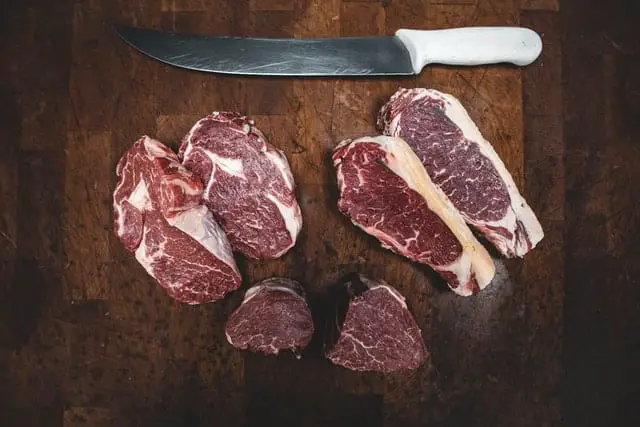Meat- An edible flesh of an animal. Let us find Where does superstore meat come from?
Superstore- A superstore is a large store which offers a wide variety of merchandise for sale.
Answer
According to WWF, livestock farming has become a big source of earning for the farmers in the United States, and in the United Kingdom, and making livestock farming more sustainable, it is important to take a less but better approach to meat and this is done by Loblaws as because all superstore meat comes from them only.
Also, with the rapid growth of population, the demand for meat production has primarily increased with beef, buffalo, and pork production.

Types of meat stored in superstores
- Pork
- Beef
- Lamb
- Goat
- Chicken
- Turkey
- Duck
- Rabbit
- Kinds of Seafood and
- Game Meat
Categories of Meat
As there used to be stratification in companies, superstores, supermarkets, etc, so does the meat industry. The meat industry categorizes meat into three basic categories.
- Red Meat- All livestock is considered as red meat
For instance- Beef, pork, etc.
- Poultry- Poultry meat generally refers to turkey and chicken. Also, it is commonly known as White Meat.
- Seafood- As the name connotes, seafood includes fish, crab, lobster, mollusks, etc.
How do superstores keep meat fresh?
As superstores are a big spot for consumers, the owners of superstores order bulk amounts of meat from suppliers, so that, they can feed the demands of their consumers, making the process of buying meat healthy and safe.
And to serve the best and fresh quality of meat, superstores, store it in the following ways:
- By cutting the useless pieces out
- By cutting only the required amount of meat for a day
- By closely monitoring and logging temperatures
- By freezing meat
- By keeping meat up until its use-by date.
Which superstores are best for buying meat?
When it comes to health, people avoid risking or degrading food quality of meat as almost every superstore uses carbon monoxide to keep meat fresh for a long-time as the monoxide maintains the color on steaks and other types of beef.
So, before buying meat, one should check the reviews of the superstores, and the best-reviewed should be visited for buying meat. Some of the best superstores are
- Whole Foods Market- It doesn’t use carbon monoxide or any cheap tricks to lure customers. Its meat used to be as fresh as the newly grown flower.
- Publix- Publix is famous for its fried chicken.
- Kroger- Kroger is famous for its transparency about the meat is sold as it claims on their website that the beef used, is 100% grass-fed, making the diet of its customer healthy.
Meat Storage
To preserve the optimal quality of meat it should be properly stored because at room temperature it invites the growth of spoilage organisms.
So, the two most common methods used for storing meat are
- Refrigeration- Fresh meat should be stored at 25 degrees Fahrenheit to 32 degrees Fahrenheit.
- Freezing
Research on Meat Production
Meat Production and consumption in the United States have increased since the 1980s.
According to the Agricultural Research Service of the USDA, total consumption of poultry and red meat in 2015 reached 221.7% pounds per person in the USA, and according to the official chart by the USDA, the appetite for meat is as follows:
| Meat Type | Meat Consumption per capita in pounds |
| Broiler | 82 pounds |
| Beef | 67.8 pounds |
| Pork | 51.6 pounds |
Environmental Causes of Meat Production
According to the report from Chatham House, a London-based think tank, the implications of the meat industry on the environment is much larger than the transportation industry as the meat production didn’t only release a good amount of greenhouse gas but it strongly leaves its methane footprint into the environment.
Negative impacts on the environment:
- Greenhouse gas emissions
- Animal waste
- High water use
- Land degradation
- Air pollution, etc.
The feed Conversion ratio of Meat
As of 2015, 44% of greenhouse gas emissions in the United States directly come from the livestock industry and the number of resources used for live rearing costs a huge impact on the environment. According to a recent study, the conversion ratio of meat is
| Meat Type | Ratio |
| Beef | 7:1 |
| Pork | 5:1 |
| Poultry | 2:5:1 |
Conclusion
As Meat has become a part of the human diet, and because of this very factor, the production of meat has become a part of the world economy with important contributions to local, national, and international trade. Also, to contribute to the environment, the meat industries are focusing on agroecological farming so that it can feed a growing population as the path towards the future of meat production.
Frequently Asked Questions(FAQs)
Question 1- Do meat production is influenced by animal breeding and genetics?
Answer- Yes
Question 2- Is it possible to know the source of meat?
Answer- Yes
Question 3- Is meat stores in the superstores are good in quality?
Answer- Yes
Question 4- Is Game Meats are expensive?
Answer- Yes
Question 5- For how long do the superstores, store meat?
Answer- For 10-14 days.
